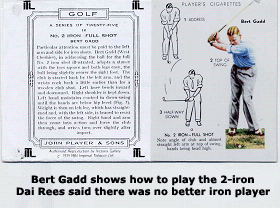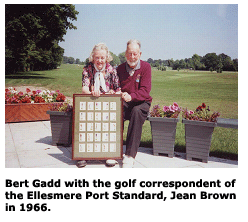|
Chapter 18 Epilogue After my health started to deteriorate I had to cut back on my golf,
but I continued to play until shortly before my ninetieth birthday.
My final handicap was 9. I had fifteen years playing as an amateur;
starting sixty years after I began my professional career; a bit
unusual – most pros do it the other way round. It was over eighty
years since I first swung a club in that Malvern lane. I cannot
begin to estimate the number of shots I played, but it must run into
a few million and remarkably I can only remember having one injury.
These days injuries seem to be far more common and Physios travel
with the tour to treat the players on a daily basis. They were not
so available in my day but when I did suffer an injury to my hand I
got help from an unusual quarter. When I was based on Merseyside the
local pros were in the habit of going to the Liverpool Stadium to
watch the boxing after we finished playing. I mentioned my problem
to the man who treated the boxers, who naturally knew a bit about
hand injuries. With a few manipulations my hand was as good as new.
 I may have been lucky to avoid injuries, but I believe that my
longevity in the games of golf – and life, was greatly assisted by a
decision I made in 1948. I can easily remember the year because it
was the last time this country had the Olympics, which we are now
bidding to stage in London again in 2012. [Confirmed in 2005] My
decision was to give up the 20-40 cigarettes a day that I had smoked
since my youth, apart from the times I resorted to a pipe (See the
cartoon on p.137 and the photo at the Penfold Tournament in 1938
(p.91)). We nearly all smoked back then; Fags were less than four
bob (20p) a packet, so it was not the financial burden it is now and
there was no suggestion that it was seriously damaging your health,
indeed before the war an advert for Kensitas Mild, “endorsed by
leading artistes of radio stage screen and opera”, had used the
caption: 'Just what the Doctor ordered'. A survey of London GPs had
revealed that 84% recommended the mild brand because it was kinder
on your throat. Maybe so, but I knew that they were doing me no
good. I may have been lucky to avoid injuries, but I believe that my
longevity in the games of golf – and life, was greatly assisted by a
decision I made in 1948. I can easily remember the year because it
was the last time this country had the Olympics, which we are now
bidding to stage in London again in 2012. [Confirmed in 2005] My
decision was to give up the 20-40 cigarettes a day that I had smoked
since my youth, apart from the times I resorted to a pipe (See the
cartoon on p.137 and the photo at the Penfold Tournament in 1938
(p.91)). We nearly all smoked back then; Fags were less than four
bob (20p) a packet, so it was not the financial burden it is now and
there was no suggestion that it was seriously damaging your health,
indeed before the war an advert for Kensitas Mild, “endorsed by
leading artistes of radio stage screen and opera”, had used the
caption: 'Just what the Doctor ordered'. A survey of London GPs had
revealed that 84% recommended the mild brand because it was kinder
on your throat. Maybe so, but I knew that they were doing me no
good.
 An alternative offered in those days was Dr J. C. Murray’s
Ozonised
Snuff – “A grand snuff tobacco impregnated with ozone during
manufacture”, as the adverts told us.
You have already seen cigarette cards picturing my brother George
and I was featured on a Player’s card myself. You will see collages
of cards picturing leading players of the past in golf clubs around
the country and in 1996 the golf correspondent of the Ellesmere Port
Standard, Jean Brown, presented the club with one that featured me
and a number of my contemporaries, including Sam King, Jimmy Adams,
Percy Alliss, Archie Compston, Aubrey Boomer, Abe Mitchell, Charles
Whitcombe, Reg Whitcombe, Arthur Lacey, Alf Padgham, Bill Davies,
George Duncan and Bill Branch– a lovely gesture to remind me of old
times whenever I sat in the bar at Ellesmere Port. An alternative offered in those days was Dr J. C. Murray’s
Ozonised
Snuff – “A grand snuff tobacco impregnated with ozone during
manufacture”, as the adverts told us.
You have already seen cigarette cards picturing my brother George
and I was featured on a Player’s card myself. You will see collages
of cards picturing leading players of the past in golf clubs around
the country and in 1996 the golf correspondent of the Ellesmere Port
Standard, Jean Brown, presented the club with one that featured me
and a number of my contemporaries, including Sam King, Jimmy Adams,
Percy Alliss, Archie Compston, Aubrey Boomer, Abe Mitchell, Charles
Whitcombe, Reg Whitcombe, Arthur Lacey, Alf Padgham, Bill Davies,
George Duncan and Bill Branch– a lovely gesture to remind me of old
times whenever I sat in the bar at Ellesmere Port.
In 1998 Nailcote Hall in Warwickshire revived the British Short
Course championship on the superb Cromwell par-3 course in the
grounds of the hotel. As a 24-year-old I had played in that event,
held in Torquay in 1933, coming third and creating an 18-hole course
record of 47. The venue for that original tournament, which lasted
until 1973, was the small course at the resort’s Palace Hotel and
the winner was Alf Padgham, the 1936 Open Champion, who completed a
Torquay double, having already won the 36-hole tournament played on
the Torquay and South Devon course at Petitor. In that event I was
joint second with Charlie Ward, a stroke behind the winner.
At the Short Course Championship Alf ‘s prize was brought to him in
a wheelbarrow - £30 in coppers. When I told them about this Nailcote
revived the tradition by presenting the current champion with £5000
in £1 coins – in a wheelbarrow. In the second year of the
NEXT |

 I may have been lucky to avoid injuries, but I believe that my
longevity in the games of golf – and life, was greatly assisted by a
decision I made in 1948. I can easily remember the year because it
was the last time this country had the Olympics, which we are now
bidding to stage in London again in 2012. [Confirmed in 2005] My
decision was to give up the 20-40 cigarettes a day that I had smoked
since my youth, apart from the times I resorted to a pipe (See the
cartoon on p.137 and the photo at the Penfold Tournament in 1938
(p.91)). We nearly all smoked back then; Fags were less than four
bob (20p) a packet, so it was not the financial burden it is now and
there was no suggestion that it was seriously damaging your health,
indeed before the war an advert for Kensitas Mild, “endorsed by
leading artistes of radio stage screen and opera”, had used the
caption: 'Just what the Doctor ordered'. A survey of London GPs had
revealed that 84% recommended the mild brand because it was kinder
on your throat. Maybe so, but I knew that they were doing me no
good.
I may have been lucky to avoid injuries, but I believe that my
longevity in the games of golf – and life, was greatly assisted by a
decision I made in 1948. I can easily remember the year because it
was the last time this country had the Olympics, which we are now
bidding to stage in London again in 2012. [Confirmed in 2005] My
decision was to give up the 20-40 cigarettes a day that I had smoked
since my youth, apart from the times I resorted to a pipe (See the
cartoon on p.137 and the photo at the Penfold Tournament in 1938
(p.91)). We nearly all smoked back then; Fags were less than four
bob (20p) a packet, so it was not the financial burden it is now and
there was no suggestion that it was seriously damaging your health,
indeed before the war an advert for Kensitas Mild, “endorsed by
leading artistes of radio stage screen and opera”, had used the
caption: 'Just what the Doctor ordered'. A survey of London GPs had
revealed that 84% recommended the mild brand because it was kinder
on your throat. Maybe so, but I knew that they were doing me no
good. An alternative offered in those days was Dr J. C. Murray’s
Ozonised
Snuff – “A grand snuff tobacco impregnated with ozone during
manufacture”, as the adverts told us.
You have already seen cigarette cards picturing my brother George
and I was featured on a Player’s card myself. You will see collages
of cards picturing leading players of the past in golf clubs around
the country and in 1996 the golf correspondent of the Ellesmere Port
Standard, Jean Brown, presented the club with one that featured me
and a number of my contemporaries, including Sam King, Jimmy Adams,
Percy Alliss, Archie Compston, Aubrey Boomer, Abe Mitchell, Charles
Whitcombe, Reg Whitcombe, Arthur Lacey, Alf Padgham, Bill Davies,
George Duncan and Bill Branch– a lovely gesture to remind me of old
times whenever I sat in the bar at Ellesmere Port.
An alternative offered in those days was Dr J. C. Murray’s
Ozonised
Snuff – “A grand snuff tobacco impregnated with ozone during
manufacture”, as the adverts told us.
You have already seen cigarette cards picturing my brother George
and I was featured on a Player’s card myself. You will see collages
of cards picturing leading players of the past in golf clubs around
the country and in 1996 the golf correspondent of the Ellesmere Port
Standard, Jean Brown, presented the club with one that featured me
and a number of my contemporaries, including Sam King, Jimmy Adams,
Percy Alliss, Archie Compston, Aubrey Boomer, Abe Mitchell, Charles
Whitcombe, Reg Whitcombe, Arthur Lacey, Alf Padgham, Bill Davies,
George Duncan and Bill Branch– a lovely gesture to remind me of old
times whenever I sat in the bar at Ellesmere Port.